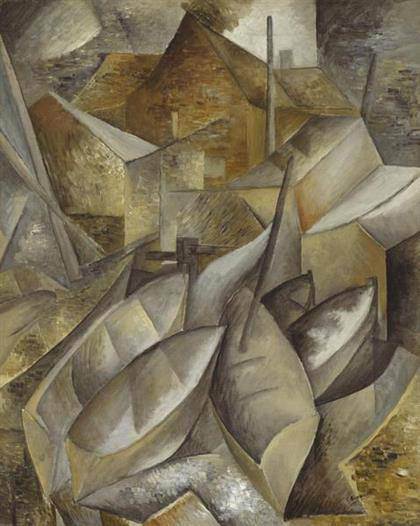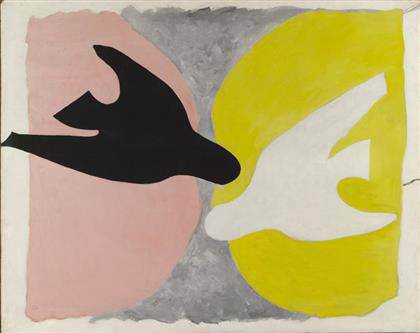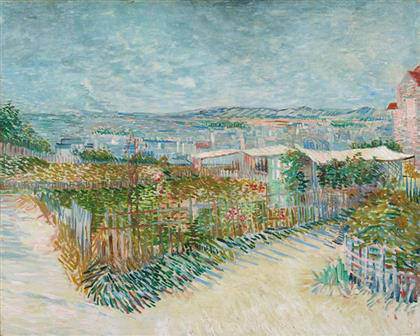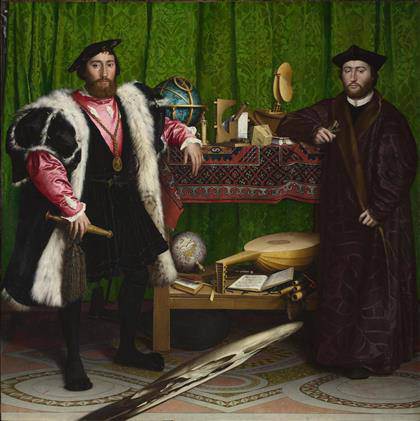
Georges Braque: “Barques de pêche (Fishing Boats)”, 1908–09, oil on canvas, the Museum of Fine Arts, Houston, gift of Audrey Jones Beck.
© 2014 Artists Rights Society (ARS), New York / ADAGP, Paris

Georges Braque: “L’oiseau noir et l’oiseau blanc (Black Bird and White Bird)”, 1960, oil on canvas, private collection, Paris.
© 2014 Artists Rights Society (ARS), New York / ADAGP, Paris.
Image © Leiris SAS Paris
Georges Braque retrospective – MFAH Houston The Museum of Fine Arts, Houston (MFAH), is the only U.S. venue to present ‘Georges Braque: A Retrospective’, the definitive retrospective of this generation that maps the evolution of Braque’s career through his major paintings and collages.
February 13 to May 11, 2014.
]]>
Source: Museum of Fine Arts, Houston
“Georges Braque: A Retrospective” displays a selection of 75 defining works, ranging from the artist’s early, bold Fauvist paintings, to the radical Cubist compositions that shaped the course of modern art, to the lyrical still lifes and landscape abstractions of his later years. It is the first retrospective of the artist presented by a U.S. museum since the 1988 exhibition organized by the Solomon R. Guggenheim Museum, New York.
Among the Wild Beasts
Georges Braque (1882–1963) was the son and grandson of house painters who specialized in trompe l’oeil decorations. Initially trained at the École des Beaux-Arts, Le Havre, and the Académie Humbert, Paris, Braque also apprenticed to enter his family’s trade. However, he soon broke with the conventions of his academic training. On encountering the work of Henri Matisse (1869–1954) and André Derain (1880–1954), artists who had been nick-named Les Fauves (“The Wild Beasts”), at the Salon d’Automne in 1905, he adopted their brilliant and at times acid colors and bold brushwork.
Braque and the Invention of Cubism
In 1907, the Salon d’Automne presented a monumental exhibition dedicated to the career of Paul Cézanne (1839-1906). Profoundly moved by the classical structure of Cézanne’s landscapes and still-life compositions, Braque began to adopt a cooler palette and a more rigorous analysis of form that was to guide the balance of his career. This new tendency was further confirmed by his first visit to the studio of Pablo Picasso (1881-1973), where he encountered the radical “Les Demoiselles d’Avignon” (1907). Within a year, Braque and Picasso initiated one of the most rigorous and fruitful artistic collaborations of the 20th century. “The things that Picasso and I said to one another during those years will never be said again, and even if they were, no one would understand them anymore,” Braque recalled. “It was like being roped together on a mountain.“
Braque at Mid-Career
While his alliance with Picasso had come to an end, Braque continued to explore the formal departures of Cubism, playing transparency and opacity against increasingly rich and densely articulated interiors. After 1917, his work also assumed a new monumentality and chromatic drama.
World War II and the Late Paintings
While Braque rarely referred directly to the conditions in France during World War II, he remained an influential presence among the artists who chose to remain there during these years. He also produced some of his most powerful paintings in the 1940s, including his extended “Billiard” series, in which the billiard table becomes both an arena and broken field.
Related content
Georges Braque retrospective at Grand Palais Paris (2013)
Follow us on:


